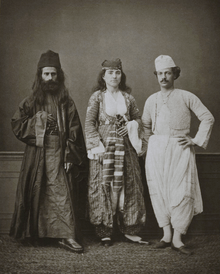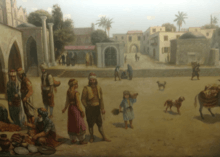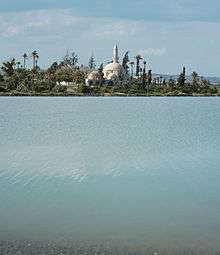Ottoman Cyprus
| Eyalet-i Ḳıbrıṣ | |||||
| Eyalet of Ottoman Empire | |||||
| |||||
.png) | |||||
| Capital | Nicosia | ||||
| History | |||||
| • | Established | 1571 | |||
| • | Disestablished | 1748 | |||
| Today part of | | ||||
Part of a series on the |
|---|
| History of Cyprus |
 |
|
|
The Eyalet of Cyprus (Ottoman Turkish: ایالت قبرص, Eyālet-i Ḳıbrıṣ)[1] was an eyalet (province) of the Ottoman Empire made up of the island of Cyprus, which was annexed into the Empire in 1571.[2] The Ottomans changed the way they administered Cyprus multiple times. It was a sanjak (sub-province) of the Eyalet of the Archipelago from 1670 to 1703, and again from 1784 onwards; a fief of the Grand Vizier (1703–1745 and 1748–1784); and again an eyalet for the short period from 1745 to 1748.[3]
Ottoman raids and conquest
During the Venetian rule, Ottomans at times raided Cyprus. In 1489, the first year of Venetian control, Turks attacked the Karpass Peninsula, pillaging and taking captives to be sold into slavery.[4] In 1539 the Turkish fleet attacked and destroyed Limassol.[4] Fearing the ever-expanding Ottoman Empire, the Venetians had fortified Famagusta, Nicosia, and Kyrenia, but most other cities were easy prey.
In the summer of 1570, the Turks struck again, but this time with a full-scale invasion rather than a raid. About 60,000 troops, including cavalry and artillery, under the command of Lala Mustafa Pasha landed unopposed near Limassol on July 2, 1570, and laid siege to Nicosia. The city fell on September 9, 1570; 20,000 Nicosians were put to death, and every church, public building, and palace was looted. Only women and boys who were captured to be sold as slaves were spared.[5][6] Word of the massacre spread, and a few days later Mustafa took Kyrenia without having to fire a shot. Famagusta, however, resisted with the Siege of Famagusta and put up a defense that lasted from September 1570 until August 1571.
The fall of Famagusta (with the death of Venetian Marcantonio Bragadin) marked the beginning of the Ottoman period in Cyprus.
Two months later, the naval forces of the Holy League, composed mainly of Venetian, Spanish, and Papal ships under the command of Don John of Austria, defeated the Turkish fleet at the Battle of Lepanto in one of the decisive battles of world history. The victory over the Turks, however, came too late to help Cyprus, and the island remained under Ottoman rule for the next three centuries.
In 1570, the Turks first occupied Cyprus, and Lala Mustafa Pasha became the first Turkish Governor of Cyprus, challenging the claims of Venice. Simultaneously, the Pope formed a coalition between the Papal States, Malta, Spain, Venice and several other Italian states, with no real result. In 1573 the Venetians left, removing the influence of the Roman Catholic Church.
Administrative history
As soon as Nicosia was conquered, Cyprus was declared an eyalet under the administration of a beylerbey, and Mustafa Pasha, the former beylerbey of Avlonya, was appointed as its beylerbey. Cyprus was divided into three sanjaks: Famagusta, Kyrenia and Paphos. Additionally, the sanjaks of Alâiye, Tarsus, İçel, Sis, Zülkadriye and Tripoli (Trablusşam) on the mainland were placed under the administration of the Cyprus eyalet. Cyprus was also divided into several kazas: Tuzla, Limassol, Episkopi, Kythrea, Paphos, Kukla, Lefka, Morphou, Hirsofu, Famagusta, Kyrenia and Mesariye. These kazas each had their own kadı or naib.[7] The sanjak of Tripoli, however, was removed from the jurisdiction of Cyprus in 1573 due to its distance and given to the Damascus Eyalet. The sanjaks of İçel, Alâiye and Tarsus were also removed in 1610 and given to the newly created Adana Eyalet.[8]
However, after the conquest of Crete, Cypriot Orthodox Church argued that Cyprus had lost importance, that trade volume had decreased and that people were emigrating. It thus requested a change in the administrative status as Cyprus could not afford remaining an eyalet. Thus, in 1670, Cyprus became a sanjak under the Eyalet of the Archipelago, under the direct control of Kapudan Pasha, the head of the Ottoman Navy. This control was exercised through an appointed mütesellim.[7] However, under this system, local aghas were the tax collectors. This magnified their power and resulted in discontent, with the rivalry between them causing a two-year long revolt in the 1680s by Boyacıoğlu Mehmed Agha.[9] This proved that this system caused a power void and was ineffective, so in 1703 Cyprus was placed directly under the control of the Grand Vizier, administered on his behalf by a muhassıl. To reduce the powers of the aghas, the muhassıl was given the power to collect taxes, as well as increased political and military power. Between 1745 and 1748, Cyprus briefly became an eyalet again. These three years, especially the reign of governor Ebubekir Pasha (1746–48) were a period of development and relative prosperity. After the end of Ebubekir Pasha's tenure, Cyprus reverted to its former status.[7]
Greek Cypriots had two very important administrative positions: the Archbishop, who headed the Orthodox Church, recognized as the sole representative of the Greek Cypriot population from the 1670s onwards, and the Dragoman, chosen from the candidates determined by the Archbishop.[7]
The muhassıl administration slowly became more and more dysfunctional. In 1764, muhassıl Çil Osman Agha was killed amidst a chaotic environment caused by his rule. Meanwhile, the ongoing war with Russia meant a deterioration in the people's welfare. Thus, with the demands of the Archbishop and the Dragoman, Cyprus was placed directly under the administration of the Imperial Council in 1785, with the muhassıl being directly appointed. These new muhassıls lacked some of their old powers, which greatly increased the influence of the Orthodox clergy as they became tax collectors.[7][10] In 1839, with the reforms under Abdülmecid I, the island once again became a sanjak of the Eyalet of the Archipelago but gained significant autonomy. The island was governed by a mutasarrıf, the kazas were consolidated into six larger kazas with their own administrative and judicial councils. A sanjak administrative council, in which Turks, Greeks and other minorities were proportionally represented, was established.[7]
In 1861, Cyprus became an independent mutasarrifate under the direct control of the Porte. However, this changed again in 1868, when Cyprus became a sanjak under the Vilayet of the Archipelago under the newly established vilayet system. This would, however, not last long, as the vilayet was administered from Dardanelles, and the long distance made the administration impractical. With the efforts of Archbishop Sophronios III of Cyprus, as well as given the drought and ravages of locusts, Cyprus was made an independent mutasarrifate once again in 1870. This arrangement lasted until 1878, when the British took over the island.[7][11][12]
Social history

The Ottoman occupation brought about two radical results in the history of the island. Since the Phoenicians in the 9th century BC, a new ethnic element appeared, the Turks. The population of Cyprus, Greeks, had now a new ruler: the Ottomans.
The Ottoman Empire gave timars—land grants—to soldiers under the condition that they and their families would stay there permanently. An action of far-reaching importance because the predefined soldiers became the nucleus of the island's Turkish community. During the 17th century the Turkish population grew rapidly, partly by conversion. Most of the Turks who had settled on the island during the three centuries of Ottoman rule remained when control of Cyprus—although not sovereignty—was ceded to Britain in 1878. Many, however, left for Turkey during the 1920s. By 1970, ethnic Turks represented 18% of the total population of the island, with ethnic Greeks representing the remainder. The distinction between the two groups was by both religion and language.

The Ottomans applied the millet system to Cyprus, which allowed religious authorities to govern their own non-Muslim minorities. This system reinforced the position of the Orthodox Church and the cohesion of the ethnic Greek population. Gradually the Archbishop of Cyprus became not only religious but ethnic leader as well, something the Ottoman Turks promoted, wanting to have somebody responsible for the loyalty of the Greek flock. In this way the Church undertook the task of the guardian of the Greek cultural legacy, although diminished since the country's independence.

Greek independence movement
| Rise of nationalism in the Balkans Nationalism under the Ottoman Empire |
|---|
1821–1829
Many Greek Cypriots supported the Greek independence effort that began in 1821, leading to severe reprisals by the Ottoman Empire. On 15 October 1821, a massive Turkish mob seized and hanged an Archbishop, five Bishops, thirty six ecclesiastics, and hanged most of the Greek and Turkish Cypriots in Larnaca and the other towns. By September 1822, sixty two Cypriot villages and hamlets had entirely disappeared.[13][14] When Greece became independent in 1829, many Cypriots sought the incorporation of Cyprus into Greece, but it remained part of the Ottoman Empire.
1849–1878
In 1869 the Suez Canal opened, and the United Kingdom of Great Britain and Ireland showed increasing interest in the island, which is situated in what had suddenly become a very convenient location. When the Turks were defeated by the Russians in 1877 and the Berlin Congress took place the next year in order to revise the treaty of St Stefano which was signed by Russia and the Ottoman Empire according to terms dictated by the former, it was officially announced on 9 July 1878 that on the 4th of preceding June, the British and the Sultan had secretly countersigned the Convention of Constantinople by virtue of which the possession and administration of Cyprus was vested in Great Britain. As exchange for control of Cyprus, the UK agreed to support Turkey in the Russian-Turkish war. This agreement was formalised as the Cyprus Convention.
Architecture and public works
Architecture

During the Ottoman era, numerous mosques, masjids, churches, public baths, bazaars, caravanserais, medreses, schools and libraries were built in Cyprus.[15] Ottoman architecture in Cyprus is closely linked to mainstream Ottoman architecture, however, there are some features that make it distinctly Cypriot. This stems from the fact that, whilst leaving Greek Orthodox churches intact, many buildings used by the Catholics, built in Gothic architecture, were converted into mosques or palaces, such as the Lala Mustafa Pasha Mosque in Famagusta and Selimiye Mosque in Nicosia. These buildings were later modified for use and thus synthesised with distinctly Ottoman elements. Gothic architecture also influenced Ottoman architecture in the island as Gothic elements were used by the Ottomans, such as in the minaret of Cami Kebir in Larnaca.[16]
The two surviving caravanserais are the monumental Büyük Han and Kumarcilar Han in Nicosia, considered to be some of the finest examples of Ottoman architecture in the island. The best known of the many libraries is the Library of Mahmud II.[17] Bazaars were very important parts of Ottoman commercial lives and in 1872, 23 bazaars were present in Nicosia alone, each with its own specialty.[18] In 1883, waqf reports published by the British authorities in Cyprus listed 81 mosques that belonged to the Evkaf Administration in Cyprus. This figure is believed to be a major underestimation by archaeologist Tuncer Bağışkan.[19] Two of the most prominent Muslim religious sites built in the Ottoman period are Hala Sultan Tekke in Larnaca and Arab Ahmet Mosque in Nicosia.
Infrastructure
The Ottoman administration brought a significant improvement to Cyprus in terms of water supply. The most notable example of this is the Bekir Pasha Aqueduct, built under the auspices of Ebubekir Pasha between 1746 and 1748. This aqueduct supplied fresh water to Larnaca and prior to its construction, local residents had to carry water on their backs for two hours.[20] Silihtar aqueduct, built between 1801 and 1803, and the Arab Ahmet aqueduct supplied water to Nicosia.[21] The authorities also encouraged the construction and improvement of artificial channels for water supply and irrigation, which greatly increased crop yield and allowed large-scale fruit production. Among villages described as prosperous due to artificial irrigation upon the British takeover of the island are Morphou, Lapithos, Polis, Lefka, Avdimou and Kolossi. Samuel Baker, who visited Cyprus in 1879, noted "mills turned by water" and "narrow lanes streaming with water" in Lefka. He also wrote that "every garden and farm was irrigated by water conducted from the mountains in artificial channels" in the northern slopes of the Kyrenia Mountains extending to the Karpas Peninsula. In Karavas, streams were diverted into artificial channels to supply water to the village.[22]
In the 19th century, a major effort was undertaken by a series of Ottoman governors to straighten and regulate the course of the Pedieos. Edhem Pasha, who served as governor in the 1840s, completed the construction of the Larnaca-Nicosia road and several bridges. Governor Mehmet Halet in the 1850s further improved the road network and harbour of Larnaca and established a grain store and market in Nicosia to encourage cattle breeding.[23]
See also
References
- Notes
- ↑ "Some Provinces of the Ottoman Empire". Geonames.de. Retrieved 25 February 2013.
- ↑ Library of the US Congress
- ↑ An Historical Geography of the Ottoman Empire, p. 137, at Google Books
- 1 2 Library of Congress
- ↑ Turnbull, Stephen (2003). The Ottoman Empire 1326–1699 (Essential Histories Series #62). Osprey Publishing. p. 58
- ↑ Hopkins, T. C. F. (2007). Confrontation at Lepanto: Christendom Vs. Islam. Macmillan p.82
- 1 2 3 4 5 6 7 "Kıbrıs (Osmanlı Dönemi)". İslam Ansiklopedisi. 25. Türk Diyanet Vakfı. 2002. pp. 374–380.
- ↑ Gökdemir, Rahim (2012), MALİYEDEN MÜDEVVER (MAD.d) 03618 NUMARALI KIBRIS CİZYE DEFTERİ (TRANSKRİPSİYON VE DEĞERLENDİRME) (PDF) (in Turkish), Adnan Menderes University, retrieved 26 April 2016
- ↑ Gazioğlu, p. 97.
- ↑ Gazioğlu, p. 98.
- ↑ George Hill (2010-09-23). A History of Cyprus. Cambridge University Press. p. 378. ISBN 978-1-108-02065-7. Retrieved 2013-05-28.
- ↑ Gazioğlu, p. 99.
- ↑ Claude Delaval Cobham, Exerpta Cypria, Cambridge University Press (1908) p. 454-455
- ↑ Sir Harry Luke Cyprus under the Turks, 1571–1878 C. Hurst & Co Publishers Ltd (September 30, 1989) ISBN 1-85065-072-1
- ↑ Bağışkan, p. 6.
- ↑ Petersen, Andrew (2002). Dictionary of Islamic Architecture. Routledge. p. 58.
- ↑ Bağışkan, p. 12.
- ↑ Bağışkan, p. 13.
- ↑ Bağışkan, p. 7.
- ↑ Gazioğlu, p. 138-9
- ↑ Keshishian, Kevork K. (1978). Nicosia: Capital of Cyprus Then and Now. The Mouflon Book and Art Centre. p. 94-98
- ↑ Gazioğlu, p. 143-7
- ↑ Gazioğlu, p. 142
- Bibliography
- Cyprus under Ottoman Empire by Official Republic of Cyprus Web site.
- Bağışkan, Tuncer (2005), Kıbrıs'ta Osmanlı Türk Eserleri, Turkish Cypriot Association of Museum Lovers
- Foglietta, U. The sieges of Nicosia and Famagusta. London:Waterlow, 1903.
- Gazioglu, Ahmet C. The Turks in Cyprus: A province of the Ottoman Empire (1571–1878). London: Rustem & Bro., 1990.
- Jennings, Ronald C. Christians and Muslims in Ottoman Cyprus and the Mediterranean world, 1571–1640. New York: New York University Press, 1993.
- Katsiaounis, Rolandos. Labour, society and politics in Cyprus during the second half of the 19th century. Nicosia: Cyprus Research Centre, 1996.
- Koumoulides, John. Cyprus and the war of Greek Independence, 1821–1829. London: Zeno, 1974.
- Kyrris, Costas, P. The Kanakaria documents, 1666–1850. Nicosia: Cyprus Research Center, 1978.
- Luke, Harry. Cyprus under the Turks, 1571–1878. London: Hurst, 1969.(Reprint of 1921 edition.)
- Mariti, Giovanni. Travels in the island of Cyprus. (C. D. Cobham translator). London: Zeno, 1971. (Reprint of 1909 edition.)
- Michael, Michalis N.; Kappler, Matthias; Gavriel, Eftihios (eds.). Ottoman Cyprus. A Collection of Studies on History and Culture. Wiesbaden: Harrassowitz Verlag, 2009.
- Papadopoullos, T. Social and historical data on population:1570–1881. Nicosia: Zavallis Press, 1965.
- Proxenika egrafa tou 19o aionos. (Consular documents of the 19th century.) Nicosia: Cyprus Research Centre, 1980.
- Ross, L. A journey to Cyprus. (February and March 1845). (C. D.Cobham translator). Nicosia: Government Printing House, 1910.
- Salvator, Louis. Levkosia: The capital of Cyprus. London Trigraph,1983. (Reprint of 1881 edition.)
- Sant Cassia, Paul. "Religion, politics and ethnicity in Cyprus during the Turkocratia(1571–1878)." Archives Europeennes de Sociologie, Tome XXVII, No. 1, 1986
